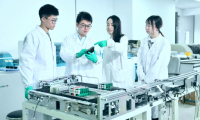
Wu, Xuli (Associate Professor) Associate Professor
Department of Preventive Medicine
Associate Professor
BIOGRAPHICAL SKETCH
NAME: Wu, Xuli
POSITION TITLE: Associate Professor, Shenzhen University School of Medicine
EDUCATION/TRAINING
|
INSTITUTION AND LOCATION |
DEGREE
|
Completion Date MM/YYYY
|
FIELD OF STUDY
|
|---|---|---|---|
|
South China Agriculture University, Guangzhou, Guangdong, China |
B. Med |
07/2000 |
Food Science |
|
South China Agriculture University, Guangzhou, Guangdong, China |
M.Sc. |
06/2003 |
Food Science |
|
South China University of Technology, Guangzhou, Guangdong, China |
Ph.D. |
06/2012 |
Food Nutrition and Safety |
|
Cornell University, Ithaca, NY, USA |
Visiting scholar |
12/2017 |
Food Nutrition and Safety |
A. Personal Statement
My long-standing research interests lie in : a) the mechanisms of binding interactions between polyphenolic compounds and proteins/enzymes; b) the potential health benefits of polyphenolic compounds derived from medicinal herbs; c) food allergens; and d) food safety assurance systems in China. I have published > 6 0 papers in peer-reviewed journals. I am currently mentoring three MSc candidates.
B. Positions and Honors
Positions and Employment
07/ 2003 – 07 / 2006 Lecturer, College of Life Sciences, Shenzhen University, Shenzhen, China
08 /20 06 – 11 /20 11 Lecturer, Shenzhen University School of Medicine, Shenzhen, China
12 /20 11 – present Associate Professor, Shenzhen University School of Medicine, Shenzhen, China
01/201 6 – present Vice Director & Co-founder, Shenzhen Key Laboratory for Natural Health Products, Shenzhen University, Shenzhen, China
C. Contributions to Science (*: corresponding/co-corresponding author)
1. Development of novel lipase and α-amylase inhibitors from dietary polyphenols
Natural polyphenols, such as lipase inhibitors and α-amylase, can reduce fat and carbohydrate absorption. As such, understanding the interactions between natural polyphenols and digestive enzymes is important in the context of obesity and postprandial blood glucose control. Since 2013, we have been investigating the lipase-inhibitory and α-amylase-inhibitory activities of dietary polyphenols and have characterized the interactions between dietary polyphenols and enzymes in detail. We have investigated the structure–activity relationships of polyphenols inhibiting enzymes with the aim of elucidating the nature of binding between dietary polyphenols and enzymes and ultimately driving the field of dietary polyphenol application.
1) Feng Y, Fangqi L, Wu XL*, Li Y, Shen YX, Lu FQ, Fan L, He ZD. Inhibitory potential of phenylpropanoid glycosides from Ligustrum purpurascens Kudingcha against α-glucosidase and α-amylase in vitro,International Journal of Food Science &Technology.October, 2015, 50(10), 2280–2289.
2) Xuli Wu*, YueFeng, Yuqin Lu, Yao Li, Long Fan, Lizhong Liu, Zhendan He *Effect of phenolic hydroxyl groups on inhibitory activities of phenylpropanoid glycosides against lipase. Journal of Functional Foods. 2017,November,38, 510-518.(JCR 1)
3) Wu XL* , He WT, Li Y , Zhang HP, Liu ZG, Wang WP, Ye Y , Cao JJ. Characterization of binding interactions of (−)-epigallocatechin-3-gallate from green tea and lipase. Journal of Agricultural and Food Chemistry.2013.sep. 61(37): 8829–8835 (JCR 1,TOP)
4) Wu XL* , He WY, Zhang HP, Li Y, Liu ZG, He ZD*. Acteoside: A lipase inhibitor from the Chinese tea Ligustrumpurpurascenskudingcha. Food Chemistry, 2014,Jan142(1):306-310(JCR2, TOP)
5) Lu Y, Zhou W, Feng Y, Li Y, Liu K , Liu L , Lin D, He Z, Wu X*, Acteoside and acyl-migrated acteoside, compounds in chinese kudingcha eea, inhibit α-amylase in vitro. Journal of Medicinal Food . May 2017, 20(6):577-585.
2. Investigating the binding interactions between dietary polyphenols and proteins/ enzymes
Dietary polyphenols may conjugate covalently or non-covalently with proteins/enzymes. This interaction may alter the structure and functional and nutritional properties of the complex, and may thus increase the potential application of the protein and polyphenols. Some polyphenolic compounds can inhibit digestive enzymes, which may be due to their interaction. Since 2011, we have investigated the binding interactions between polyphenols and food proteins to help maximize the use of food proteins and minimize anti-nutritional effects.
1) YueFeng, MoyangLv , YuQin Lu, Ke Liu, Lizhong Liu, Zhendan He, Kaimin Wu, Xinrong Wang, Baoshuang Zhang, Xuli Wu *. Characterization of binding interactions between selected phenylpropanoid glycosides and trypsin. Food Chemistry, 243, 15 March 2018, 118-124.(JCR 1,TOP)
2) Wu XL*, Wang WP, Zhu T, Liang T, Lu FP, He WY, Zhang HP, Liu ZG, Gao KP, He SH, He ZD*. Phenylpropanoid glycoside inhibition of pepsin, trypsin and α-chymotrypsin enzyme activity in Kudingcha leaves from Ligustrum purpurascens. Food Research International, December, 2013, 54(2), 1376–1382.(JCR 2)
3) Li Y, Lu FQ, Feng Y, Wu XL*.Binding interaction between (−)-epigallocatechin-3-gallate (EGCG) of green tea and pepsin. Acta Alimentaria, March 2016, 45(1): 129-140
4) Wu XL, Raje D, Wu H, Liu ZG*, He QQ, Zeng XJ. Studies on the interaction of EGCG with bovine β-lactoglobulin by spectroscopic methods and docking. International Journal of Dairy Technology, July, 2013, 66(1): 7-13.
5) Wu XL, Wu H, Liu MX, Liu ZG*, Xu H, Lai FR.Analysis of binding interaction between (−)-epigallocatechin (EGC) and β-lactoglobulin by multi-spectroscopic method. SpectrochimActa A, Nov 2011, 82(1): 164–168.
6) Wu XL*, He WY, Wang WP, LuoXp, Cao Hy,Lin LX, Feng KQ, Liu ZG. Investigation of the interaction between (-)-epigallocatechin-3-gallate with trypsin and α-chymotrypsin. International Journal of Food Science &Technology.November2013, 48(11):2340-2347.
3. Developing allergen detection methods and reducing food allergen allergenic capacity
Regulators and the food industry have developed rapid, highly selective methods to detect allergens in food products due to the increase in food allergies over recent years. Since 2012, we have developed a two-site βLG specific, monoclonal antibody (mAb)-based sandwich gold immunochromatography assay (GICA) that can detect βLG in food products in a fast, simple, highly selective and quantitative way. We have also developed a double-antibody sandwich immunoassay for peanut and milk allergens using surface plasmon resonance (SPR). It is crucial to develop new methods that reduce allergenicity but do not destroy the functional properties of the food allergen. Finally, we have developed a method to reduce βLG allergenicity by conjugating it with functional oligosaccharides and dietary polyphenols. This approach is a novel method to reduce food protein allergenicity and may be used to produce hypoallergenic foods.
1) Xuli Wu*, Yuqin Lu, Haoxie Xu, Dongxu Lin, Zhendan He, Haiqiang Wu, Lizhong Liu, ZimeiWang. Reducing the allergenic capacity of β-lactoglobulin by covalent conjugation with dietary polyphenols. Food chemistry, 2018, Auguest, Volume 256, 1 August 2018, 427-434. (JCR 1,TOP)
2) Wu XL*, Li Y, Liu B,Feng Y, He WY, Liu ZG, Liu LZ, Wang ZM, Huang HZ. Two-site antibody immunoanalytical detection of food allergens by surface plasmon resonance. Food Analytical Methods,March 2016, 9(3): 582-588.(JCR 2)
3) Wu XL*, He WY, Wan WP, Hu DS, Wu H, Luo XP, Liu ZG. A simple and fast detection method for bovine milk residues in foods:a two-site monoclonal antibody immunochromatography assay. Journal of Food Science, Mar 2013, 78(3):452-457.
4) Wu XL, Wan WP,Xia LX, X Hong, Wu Hu, Liu ZG*. In Vitro Refolding Process of Bovine Allergen β-lactoglobulin by Multi-spectroscopic Method. Biomedical and Environmental Sciences, Jun 2012, 25(3): 334-339.
5) Wu XL, Zhong XJ, Liu MX, Xia LX,Feng KQ, Wu H, Liu ZG*. Reduced allergenicity of β-lactoglobulin in vitro by tea catechins binding. Food and Agricultural Immunology, May, 2013, 24(3): 305-313
6) Wu XL, Liu MX, Xia LX, Wu H, Liu ZG*, Xu XF. Conjugation of functional oligosaccharides reduced in vitro allergenicity of β-lactoglobulin.Food and Agricultural Immunology, Jun 2013, 24(4): 379-391
7) Wu XL, Zhu QQ, Cheng XJ, Xu H, Liu ZG, Wu H*. Spectroscopic Studies on the Relationship between Heat Treatment Process and Immunogenicity of β-lactoglobulin in Milk. Spectroscopy and Spectral Analysis,Aug 2011,31(8):2205-2209.
8) Wu XL, Zhu QQ, Cheng XJ, Xu H, Liu ZG*. Spectroscopic Studies on the Relationship between heat Treatment Process and Immunogenicity of Lysozyme in Hen’s Egg. Chinese Journal of Analytical Chemistry, Feb 2011, 39(2) 198-202.
4. Food safety assurance systems in China
Food safety is a sensitive and global issue and over recent years, China has made great progress in food safety. However, the Chinese government still faces serious problems in ensuring food safety. Effective food safety assurance systems are essential to maintain the safety of domestic, exported and imported food. We have collected comprehensive information concerning the food safety assurance systems in China and have investigated the supervisory system of total food safety in China. We analyzed the industrial chain of the production and sale of gutter oil in China and the impediments to and countermeasures being implemented in the supervision of this industry.
1) Xuli Wu*, Yuqin Lu, Haoxie Xu, Moyang Lv, Dongsheng Hu, Zhendan He, Lizhong Liu, Zhimei Wang , Yue Feng. Challenges to Improve the Safety of Dairy Products in China. Trends in Food Science & Technology, June 2018, 76: 6-14. (JCR 1,TOP)
2) Lu FQ, Wu XL*. China food safety hits the “gutter”. Food Control, July 2014, 41(1), 134-138.(JCR 2)
3) Wu XL, Wu H, Xia LX, Ji KM, Liu ZG*, Chen JJ, Hu DS, Gao C, Wu Y. Socio-technical innovations for total food chain safety during the 2008 Beijing Olympics and Paralympics and beyond. Trends in Food Science & Technology, Jan 2010,21(1): 44-51 (JCR 1,TOP)
4) Wu XL*, Ye Y, Hu DH, LiuZG, CaoJJ. Food safety assurance systems in Hong Kong. Food Control.2014, March, 37(1):141-147(JCR 2)
D. Research Support
Ongoing Research Support
Funding for Technology Development Project of Guangdong Province (2015A010107017), 08/2015 to 08/2018
Xuli Wu, PI $300,000
Investigating the anti-obesity mechanism and product development of Kuding tea
Foundation of Shenzhen (JCYJ JCYJ20170818143841444), 04/2018 to 04/2020
Xuli Wu, PI $400,000
Functional changes of capacity of β-lactoglobulin by covalent conjugation with dietary polyphenols
Natural Science Funding of Guangdong Province (2015A030313558), 08/2015 to 08/2018
Xuli Wu, PI $100,000
Effects of functional factors in phenylpropanoid glycosides from Ligustrum purpurascens Kudingcha on obesity
Completed Research Support
Science Foundation of Shenzhen (JCYJ20140418091413497), 01/2015 to 12/2016
Xuli Wu, PI $300,000
Inhibitory potential of phenylpropanoid glycosides from Ligustrum purpurascens Kudingcha against lipase and α-amylase
Science Foundation of Shenzhen (No.CXZZ20150529165110750), 08/2015 to 08/2017
Xuli Wu, PI $1,500,000
Investigating of the key functional factors from Chinese traditional medicine which can use both as food and medicine
Shenzhen Funding for Technology Development Project (CXZZ20130320165017541), 01/2013 to 12/2015
Xuli Wu, PI $300,000
A simple and fast detection method for bovine milk residues in foods
Medical Technological Research Funding of Guangdong Province (WSTJJ20140101440508197710190438) 01/2013 to 12/2014
Xuli Wu, PI $5,000
Characterization of binding interactions of catechin from green tea and bovine milk protein
National Natural Science Foundation of China (NSFC31101280), 01/2010 to 12/2012
Xuli Wu, vice-PI $200,000
Investigating molecular mechanism of Ara h1 from peanut interact with antibody
Natural Science Funding of Guangdong Province (S2012010008514), 01/2009 to 12/2011
Xuli Wu, PI $50,000
Reduced allergenicity of β-lactoglobulin in vitro by tea catechins binding
E. Peer-reviewed publications (*corresponding author)
1) Xuli Wu*, Yuqin Lu, Haoxie Xu, Dongxu Lin, Zhendan He, Haiqiang Wu, Lizhong Liu, ZimeiWang. Reducing the allergenic capacity of β-lactoglobulin by covalent conjugation with dietary polyphenols. Food chemistry, 2018, Auguest, Volume 256, 1 August 2018, 427-434. (JCR 1,TOP)
2) Wu XL*, Li Y, Liu B,Feng Y, He WY, Liu ZG, Liu LZ, Wang ZM, Huang HZ. Two-site antibody immunoanalytical detection of food allergens by surface plasmon resonance. Food Analytical Methods,March 2016, 9(3): 582-588.(JCR 2)
3) Wu XL*, He WY, Wan WP, Hu DS, Wu H, Luo XP, Liu ZG. A simple and fast detection method for bovine milk residues in foods:a two-site monoclonal antibody immunochromatography assay. Journal of Food Science, Mar 2013, 78(3):452-457.
4) Wu XL, Wan WP,Xia LX, X Hong, Wu Hu, Liu ZG*. In Vitro Refolding Process of Bovine Allergen β-lactoglobulin by Multi-spectroscopic Method. Biomedical and Environmental Sciences, Jun 2012, 25(3): 334-339.
5) Wu XL, Zhong XJ, Liu MX, Xia LX,Feng KQ, Wu H, Liu ZG*. Reduced allergenicity of β-lactoglobulin in vitro by tea catechins binding. Food and Agricultural Immunology, May, 2013, 24(3): 305-313
6) Wu XL, Liu MX, Xia LX, Wu H, Liu ZG*, Xu XF. Conjugation of functional oligosaccharides reduced in vitro allergenicity of β-lactoglobulin.Food and Agricultural Immunology, Jun 2013, 24(4): 379-391
7) Wu XL, Zhu QQ, Cheng XJ, Xu H, Liu ZG, Wu H*. Spectroscopic Studies on the Relationship between Heat Treatment Process and Immunogenicity of β-lactoglobulin in Milk. Spectroscopy and Spectral Analysis,Aug 2011,31(8):2205-2209.
8) Wu XL, Zhu QQ, Cheng XJ, Xu H, Liu ZG*. Spectroscopic Studies on the Relationship between heat Treatment Process and Immunogenicity of Lysozyme in Hen’s Egg. Chinese Journal of Analytical Chemistry, Feb 2011, 39(2) 198-202.
9) YueFeng, MoyangLv , YuQin Lu, Ke Liu, Lizhong Liu, Zhendan He, Kaimin Wu, Xinrong Wang, Baoshuang Zhang, Xuli Wu *. Characterization of binding interactions between selected phenylpropanoid glycosides and trypsin. Food Chemistry, 243, 15 March 2018, 118-124.(JCR 1,TOP)
10) Wu XL*, Wang WP, Zhu T, Liang T, Lu FP, He WY, Zhang HP, Liu ZG, Gao KP, He SH, He ZD*. Phenylpropanoid glycoside inhibition of pepsin, trypsin and α-chymotrypsin enzyme activity in Kudingcha leaves from Ligustrum purpurascens. Food Research International, December, 2013, 54(2), 1376–1382.(JCR 2)
11) Li Y, Lu FQ, Feng Y, Wu XL*.Binding interaction between (−)-epigallocatechin-3-gallate (EGCG) of green tea and pepsin. Acta Alimentaria, March 2016, 45(1): 129-140
12) Wu XL, Raje D, Wu H, Liu ZG*, He QQ, Zeng XJ. Studies on the interaction of EGCG with bovine β-lactoglobulin by spectroscopic methods and docking. International Journal of Dairy Technology, July, 2013, 66(1): 7-13.
13) Wu XL, Wu H, Liu MX, Liu ZG*, Xu H, Lai FR.Analysis of binding interaction between (−)-epigallocatechin (EGC) and β-lactoglobulin by multi-spectroscopic method. SpectrochimActa A, Nov 2011, 82(1): 164–168.
14) Wu XL*, He WY, Wang WP, LuoXp, Cao Hy,Lin LX, Feng KQ, Liu ZG. Investigation of the interaction between (-)-epigallocatechin-3-gallate with trypsin and α-chymotrypsin. International Journal of Food Science &Technology.November2013, 48(11):2340-2347.
15) Feng Y, Fangqi L, Wu XL*, Li Y, Shen YX, Lu FQ, Fan L, He ZD. Inhibitory potential of phenylpropanoid glycosides from Ligustrum purpurascens Kudingcha against α-glucosidase and α-amylase in vitro,International Journal of Food Science &Technology.October, 2015, 50(10), 2280–2289.
16) Xuli Wu*, YueFeng, Yuqin Lu, Yao Li, Long Fan, Lizhong Liu, Zhendan He *Effect of phenolic hydroxyl groups on inhibitory activities of phenylpropanoid glycosides against lipase. Journal of Functional Foods. 2017,November,38, 510-518.(JCR 1)
17) Wu XL* , He WT, Li Y , Zhang HP, Liu ZG, Wang WP, Ye Y , Cao JJ. Characterization of binding interactions of (−)-epigallocatechin-3-gallate from green tea and lipase. Journal of Agricultural and Food Chemistry.2013.sep. 61(37): 8829–8835 (JCR 1,TOP)
18) Wu XL* , He WY, Zhang HP, Li Y, Liu ZG, He ZD*. Acteoside: A lipase inhibitor from the Chinese tea Ligustrumpurpurascenskudingcha. Food Chemistry, 2014,Jan142(1):306-310(JCR2, TOP)
19) Lu Y, Zhou W, Feng Y, Li Y, Liu K , Liu L , Lin D, He Z, Wu X*, Acteoside and acyl-migrated acteoside, compounds in chinese kudingcha eea, inhibit α-amylase in vitro. Journal of Medicinal Food . May 2017, 20(6):577-585.
20) Xuli Wu*, Yuqin Lu, Haoxie Xu, Moyang Lv, Dongsheng Hu, Zhendan He, Lizhong Liu, Zhimei Wang , Yue Feng. Challenges to Improve the Safety of Dairy Products in China. Trends in Food Science & Technology, June 2018, 76: 6-14. (JCR 1,TOP)
21) Lu FQ, Wu XL*. China food safety hits the “gutter”. Food Control, July 2014, 41(1), 134-138.(JCR 2)
22) Wu XL, Wu H, Xia LX, Ji KM, Liu ZG*, Chen JJ, Hu DS, Gao C, Wu Y. Socio-technical innovations for total food chain safety during the 2008 Beijing Olympics and Paralympics and beyond. Trends in Food Science & Technology, Jan 2010,21(1): 44-51 (JCR 1,TOP)
23) Wu XL*, Ye Y, Hu DH, LiuZG, CaoJJ. Food safety assurance systems in Hong Kong. Food Control.2014, March, 37(1):141-147(JCR 2)
24) LL Shen, QQ Zhu, H Xu, XLWu, HF Xiao, KZ hou, M Ying, SL Tian, G Liu, ZL Hu, ZG, Liu. Effect of heat treatment on structure and immunogenicity of recombinant peanut protein Ara h 2.01.LWT - Food Science and Technology, Mar 2015, 60(2): 964-969.
25) Chen JJ, Xia LX, Wu XL, Yang SH, Ji KM, Liu ZG*, Tang MJ, Gao C. A practical test system for sensitive, rapid screening and authentication of peanut allergens in imported and exported food products in Chinese Customs Original Research Article. Food Control, Jan 2012, 23(1): 154-158.
26) Hu XP, Shao MM, Song X, Wu XL, Qi L, Zheng K, Fan L, Liao CH, Li CY, He J, Hu YJ, Wu HQ, Li SH, Zhang J, Zhang FX, He ZD. Anti-influenza virus effects of crude phenylethanoid glycosides isolated from ligustrumpurpurascens via inducing endogenous interferon-γ. Journal ofEthnopharmacol. 2016 Feb 17;179:128-36.
27) Zheng K, Liao C, Li Y, Fan X, Fan L, Xu H, Kang Q, Zeng Y, Wu X, Wu H, Liu L, Xiao X, Zhang J, Wang Y, He Z.Gypenoside L, Isolated from Gynostemmapentaphyllum, Induces Cytoplasmic Vacuolation Death in Hepatocellular Carcinoma Cells through Reactive-Oxygen-Species-Mediated Unfolded Protein Response.Journal of Agricuture&Food Chemistry.Feb 2016, 64 (8): 1702–1711
28) Liu ZG*, Liu H, Liu XY, Wu XL. Purification and cloning of a novel antimicrobial peptide from salivary glands of the hard tick, Ixodessinensis. Comparative Biochemistry & Physiology Part B Biochemistry & Molecular Biology Apr, 2008, 149(4):557-561.
29) Ji KM, Chen JJ, Li M, Liu ZG*, Wang CB, Zhan ZK, Wu XL, Xia QY. Anaphylactic shock and lethal anaphylaxis caused by food consumption in China. Trends in Food Science & Technology,May 2009, 20(5): 227-231.
30) Ji KM*, Li CL, Meng G, Huan AD, Wu XL. New BZLF1 sequence variations in EBV-associated undifferentiated nasopharyngeal carcinoma in southern China,Archives of Virology, Sep 2008, 153(10): 1949-1953.
31) Li M, Ji KM*, Liu ZG, Wang CB, Chen JJ, Zhan Zk, Wu XL, Food allergen labeling during the 2008 Beijing Olympics and Paralympics and beyond. Trends in Food Science & Technology, Feb 2009, 20(2): 100-102.
32) Ji KM*, Chen JJ, Li M, Liu ZG, Xia LX, Wang CB, Zhan ZK, Wu XL. Comments on serious anaphylaxis caused by nine Chinese herbal injections used to treat common colds and upper respiratory tract infections. Regulatory Toxicology & Pharmacology, Nov 2009, 55(2): 134-138.
33) Zheng K, Jiang Y, Liao C, Hu X, Li Y, Zeng Y, Zhang J, Wu X, Wu H, Liu L, Wang Y, He Z.NOX2-Mediated TFEB Activation and Vacuolization Regulate Lysosome-Associated Cell Death Induced by Gypenoside L, a Saponin Isolated from Gynostemmapentaphyllum.Journal of Agricuture & Food Chemistry.. 2017 Aug 9; 65(31):6625-6637.
34) Liao C, Zheng K, Li Y, Xu H, Kang Q, Fan L, Hu X, Jin Z, Zeng Y, Kong X, Zhang J, Wu X, Wu H, Liu L, Xiao X, Wang Y, He Z.Gypenoside L inhibits autophagic flux and induces cell death in human esophageal cancer cells through endoplasm reticulum stress-mediated Ca2+ release.Oncotarget. 2016 Jul 26;7(30):47387-47402. ISSN:1554-8627
35) Zheng K, Li Y, Wang S, Wang X, Liao C, Hu X, Fan L, Kang Q, Zeng Y, Wu X, Wu H, Zhang J, Wang Y, He Z.Inhibition of autophagosome-lysosome fusion by ginsenoside Ro via the ESR2-NCF1-ROS pathway sensitizes esophageal cancer cells to 5-fluorouracil-induced cell death via the CHEK1-mediated DNA damage checkpoint.Autophagy. 2016 Sep;12(9):1593-1613.








用户登录
还没有账号?
立即注册